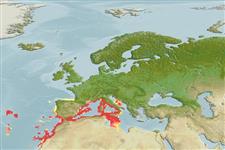>
Gadiformes (Cods) >
Moridae (Morid cods)
Etymology: Physiculus: Diminutive of Greek, physa = tube.
Eponymy: Reinhard Carl Friedrich von Dalwigk (1802–1888) was a German politician in the State of Hesse. [...] (Ref. 128868), visit book page.
More on author: Kaup.
Environment: milieu / climate zone / Tiefenbereich / distribution range
Ökologie
seewasser benthopelagisch; tiefenbereich 100 - 738 m (Ref. 45593). Subtropical; 44°N - 25°N, 29°W - 17°E
Eastern Atlantic: western Mediterranean, Madeira, Great Meteor Bank and south along the African coast to about 25°N.
Size / Gewicht / Alter
Geschlechtsreife: Lm ? range ? - ? cm
Max length : 30.0 cm TL Männchen/unbestimmt; (Ref. 1371)
Rückenflossenstacheln (insgesamt) : 0; Afterflossenstacheln: 0; Afterflossenweichstrahlen: 66 - 75. Ventral light organ between pectoral fin bases. Color is pinkish tan, oral cavity pale.
Body shape (shape guide): elongated; Cross section: oval.
Occurs on the continental slope (Ref. 4774).
Life cycle and mating behavior
Geschlechtsreife | Fortpflanzung | Ablaichen | Eier | Fecundity | Larven
Cohen, D.M., T. Inada, T. Iwamoto and N. Scialabba, 1990. FAO species catalogue. Vol. 10. Gadiform fishes of the world (Order Gadiformes). An annotated and illustrated catalogue of cods, hakes, grenadiers and other gadiform fishes known to date. FAO Fish. Synop. 125(10). Rome: FAO. 442 p. (Ref. 1371)
IUCN Rote Liste Status (Ref. 130435: Version 2025-1)
Bedrohung für Menschen
Harmless
Nutzung durch Menschen
Fischereien: kleinfischerei
Tools
Zusatzinformationen
Download XML
Internet Quellen
Estimates based on models
Preferred temperature (Ref.
123201): 13.1 - 14.9, mean 13.9 °C (based on 77 cells).
Phylogenetic diversity index (Ref.
82804): PD
50 = 0.5000 [Uniqueness, from 0.5 = low to 2.0 = high].
Bayesian length-weight: a=0.00112 (0.00057 - 0.00220), b=2.82 (2.64 - 3.00), in cm total length, based on LWR estimates for this species & (Sub)family-body (Ref.
93245).
Trophic level (Ref.
69278): 3.4 ±0.4 se; based on size and trophs of closest relatives
Widerstandsfähigkeit (Ref.
120179): mittel, Verdopplung der Population dauert 1,4 - 4,4 Jahre. (Preliminary K or Fecundity.).
Fishing Vulnerability (Ref.
59153): Low vulnerability (20 of 100).
🛈
Nutrients (Ref.
124155): Calcium = 61 [29, 131] mg/100g; Iron = 0.852 [0.454, 1.595] mg/100g; Protein = 17.4 [15.8, 18.9] %; Omega3 = 0.267 [0.134, 0.510] g/100g; Selenium = 41 [17, 89] μg/100g; VitaminA = 41.7 [11.5, 158.4] μg/100g; Zinc = 0.733 [0.490, 1.116] mg/100g (wet weight);
